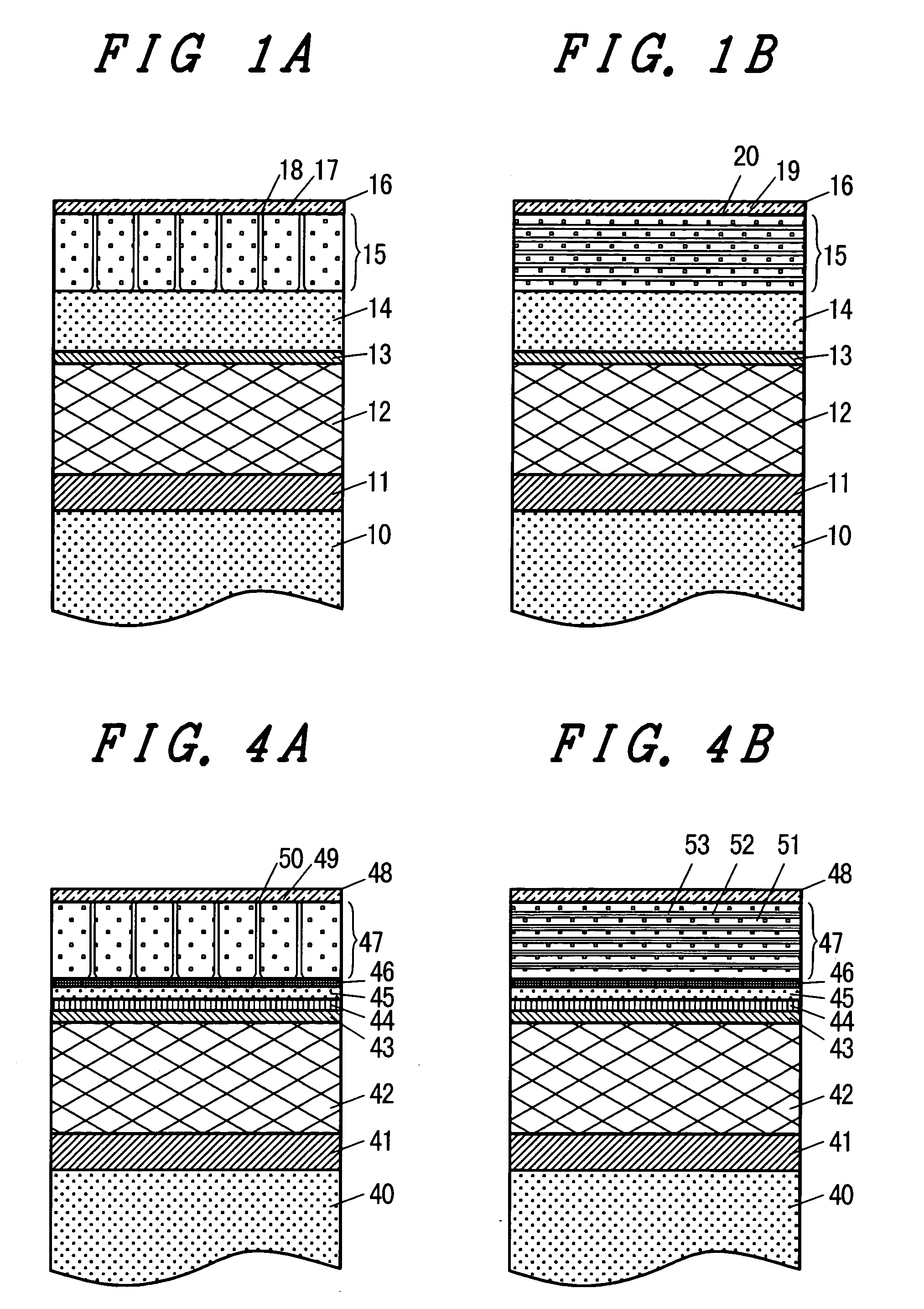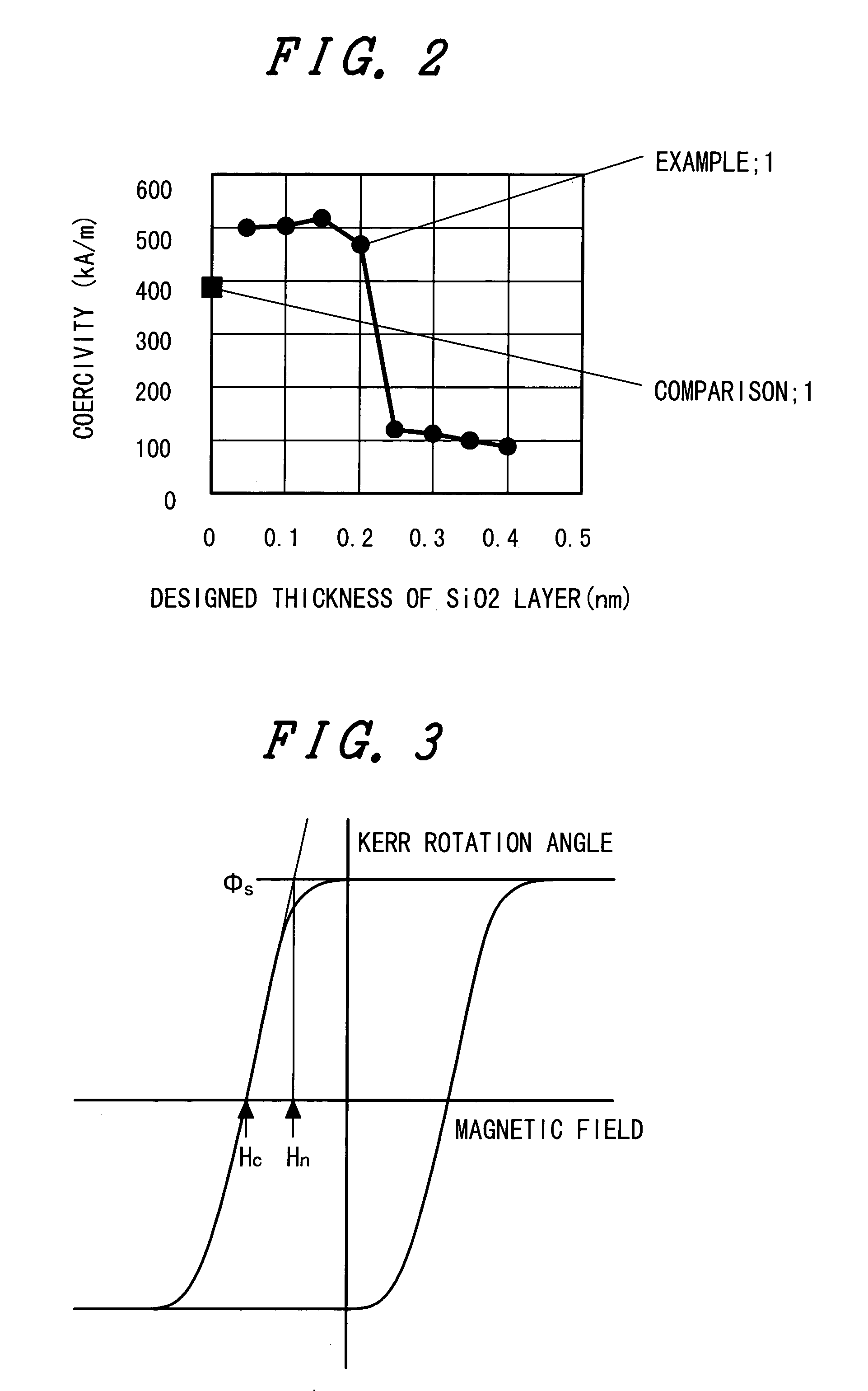Perpendicular magnetic recording medium and method of manufacturing it
a magnetic recording medium and perpendicular technology, applied in the field of perpendicular magnetic recording medium, can solve the problems of insufficient writing performance of the recording head, loss of recorded information, and thickness of the recording layer, and achieve the effects of small hn/hc, reduced thermal stability, and reduced thickness
- Summary
- Abstract
- Description
- Claims
- Application Information
AI Technical Summary
Benefits of technology
Problems solved by technology
Method used
Image
Examples
example 1
[0042]The perpendicular magnetic recording media of this example were formed by using a sputtering system (C-3010), a manufacture of ANELVA Corporation. This sputtering system comprises ten process chambers and a single substrate loading chamber which are independently degased. After every process chamber was degased to the vacuum of 1×10−5 Pa or less, a carrier having a substrate mounted thereon was moved into each process chamber, the processes were executed in order.
[0043]Magnetron sputter cathodes of a magnetic rotation type were disposed in the sputtering process chambers and film deposition was performed using a target with a diameter of 110 mm. A metal film and a carbon film were formed by DC sputtering and an oxide film by RF sputtering. A special cathode called a rotating cathode was disposed in one sputtering process chamber and multilayers were formed using this cathode.
[0044]As three cathodes power given to which can be controlled independently of the rotating cathode ar...
example 2
[0058]The perpendicular magnetic recording media of Example 2 were prepared with similar film structures to and the same process conditions as those of Example 1 except for the intermediate layer and the recording layer. FIG. 4A is a cross-sectional structural view showing one example of the perpendicular magnetic recording medium according to the invention. The following will discuss the procedures of preparing the intermediate layer and recording layer of this medium. A recording layer 46 was formed by cooling down the substrate until the substrate temperature, which had arisen by heating after the formation of the soft magnetic underlayer, became 100° C. or lower, forming a Pd intermediate layer 43 with a thickness of 1.5 nm, an MgO intermediate layer 44 with a thickness of 1 nm, a Pd intermediate layer 45 with a thickness of 1.5 nm and an intermediate layer 46 of an alloy of Pd and 10 at % of B with a thickness of 3 nm in order, and then repeatedly forming a Pd film, a Co film a...
example 3
[0065]The perpendicular magnetic recording media of Example 3 were prepared with similar film structures to and the same process conditions as those of Example 1 except for the intermediate layer and the recording layer.
[0066]FIG. 6A is a cross-sectional structural view showing one example of the perpendicular magnetic recording medium according to the invention. The following will discuss the procedures of preparing the intermediate layer and recording layer of this medium.
[0067]After the substrate was cooled down until the substrate temperature, which had arisen by heating after the formation of the soft magnetic underlayer, became 100° C. or lower, a Ta intermediate layer 63 with a thickness of 1 nm and an intermediate layer 64 with a thickness of 20 nm comprised of a mixture of Ru and Si oxide were formed, on which a recording layer 65 with a thickness of 14 nm made of an alloy of Co, 13 at % of Cr and 14 at % of Pt and an Si oxide and further a carbon protective layer 66 with a...
PUM
| Property | Measurement | Unit |
|---|---|---|
| thickness | aaaaa | aaaaa |
| diameter | aaaaa | aaaaa |
| diameter | aaaaa | aaaaa |
Abstract
Description
Claims
Application Information
 Login to View More
Login to View More - R&D
- Intellectual Property
- Life Sciences
- Materials
- Tech Scout
- Unparalleled Data Quality
- Higher Quality Content
- 60% Fewer Hallucinations
Browse by: Latest US Patents, China's latest patents, Technical Efficacy Thesaurus, Application Domain, Technology Topic, Popular Technical Reports.
© 2025 PatSnap. All rights reserved.Legal|Privacy policy|Modern Slavery Act Transparency Statement|Sitemap|About US| Contact US: help@patsnap.com



